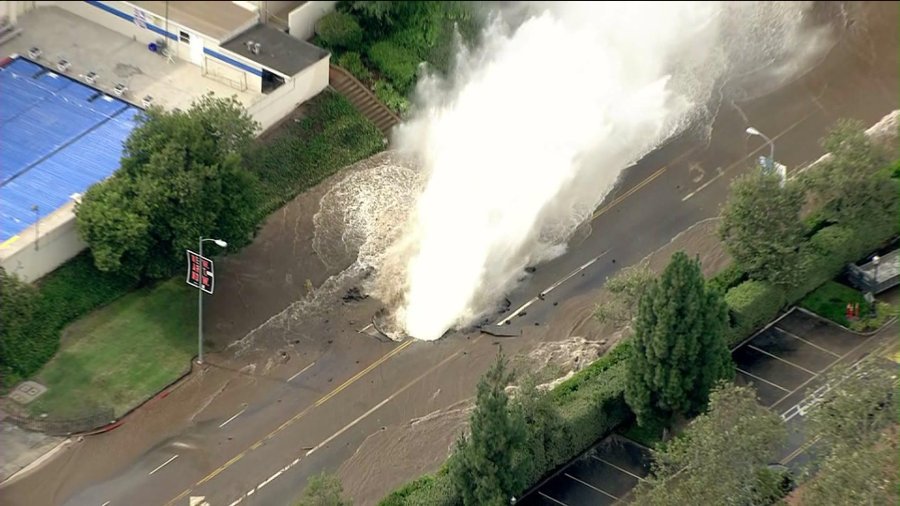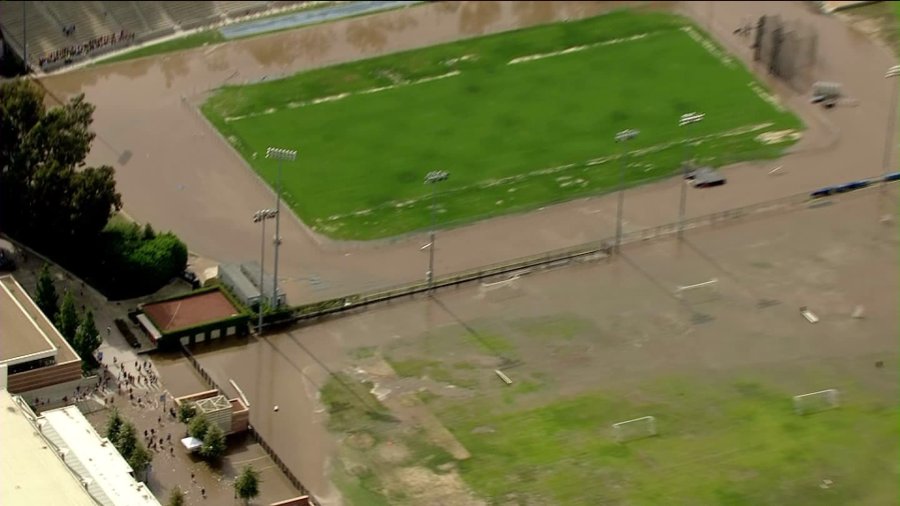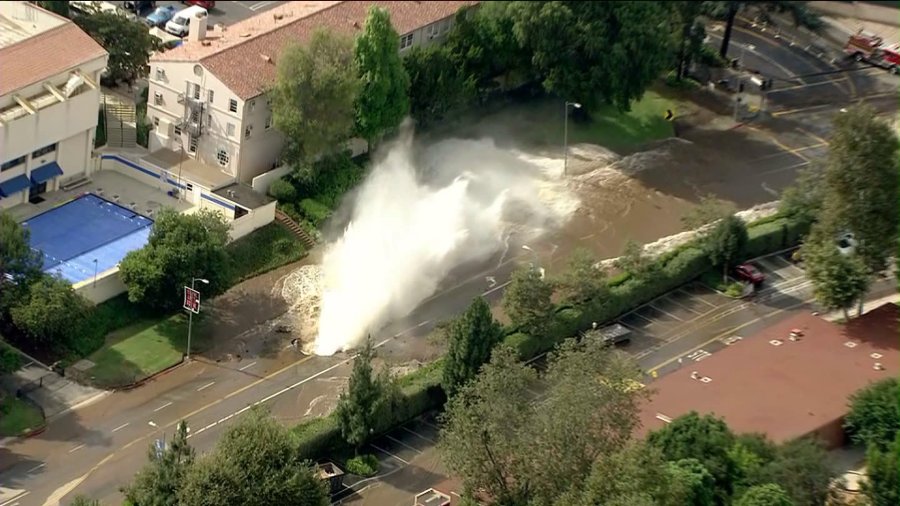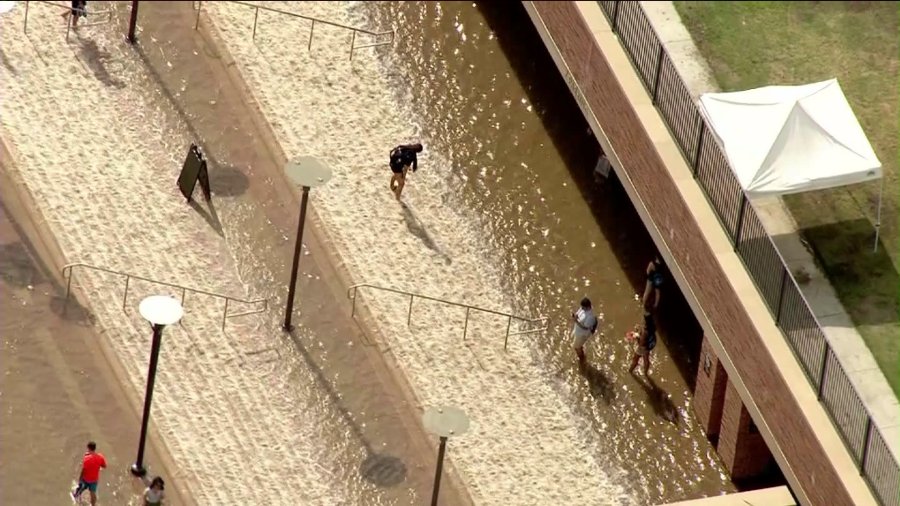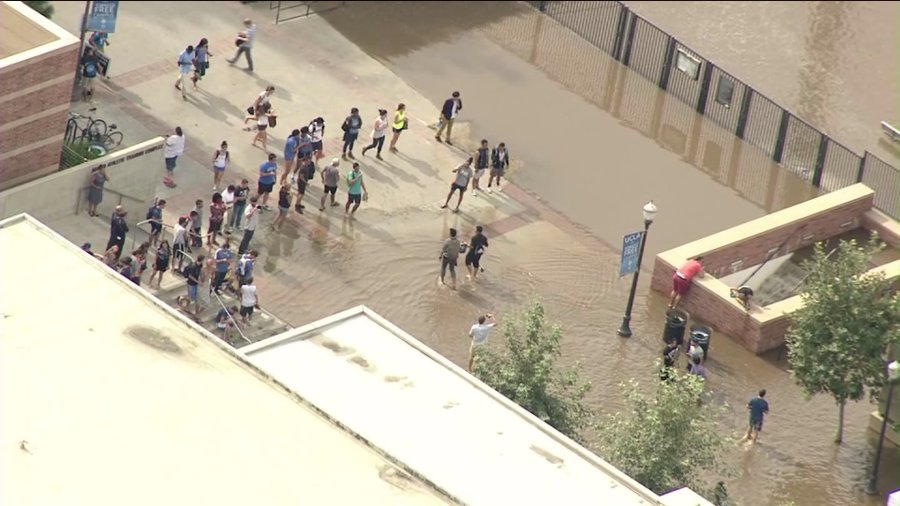DWP officials were hoping to have Sunset Boulevard open by Friday night after a 93-year-old water main burst under the street near UCLA, causing a massive flood that inundated several structures on the Westwood campus and prompted the closure of the busy thoroughfare.
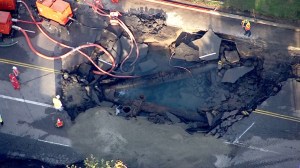
The 36-inch valve was finally closed as of 9 p.m. and repair work was underway, DWP Director of Water Distribution Joe Castruita said at a news conference Wednesday night.
Some 20 million gallons of water spilled out following the rupture, which occurred in the 10600 block of Sunset (map) shortly before 3:30 p.m. Tuesday, according to the Los Angeles Department of Water and Power.
“That’s one hell of a pothole,” Councilman Joe Buscaino said Wednesday afternoon. “This reminds us of the critical need to invest in our critical infrastructure.”
The pipe break had caused a 30-foot geyser and created a 15-foot wide sinkhole in the middle of heavily trafficked Sunset Boulevard, which was subsequently closed between Hilgard and Veteran avenues. That shutdown was expected to continue through at least Thursday.
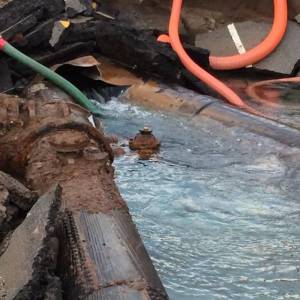
The incident was compared by DWP officials to a massive rupture of a 62-inch pipe in Coldwater Canyon in 2009, when damage to many water mains across the city was linked to two-day-per-week watering restrictions.
On Wednesday, water flow from the ruptured pipe was slowing as crews worked to fully close off aging valves along two trunklines that connect at the point of a “Y” juncture where the break occurred, according to the DWP manager in charge of the utility’s water operations.
“Closing aged valves that operate at high pressure is a complex operation to ensure additional breaks on the lines do not occur,” DWP stated in a news release.
Water officials planned to use an inflatable “balloon plug” to stop the flow and allow the pipe juncture to be removed and replaced “without having to shut down other major water trunk lines serving LA’s Westside.” But it turned out that was not necessary.
Crews had just started testing the plug when other workers were able to successfully close the valves, the DWP said in a statement Wednesday night.
Officials had originally estimated that 8 to 10 million gallons of water spilled, but that figure was raised at the news conference. Twenty million gallons is about 4 percent of the city’s daily water use, according to LADWP.
UCLA officials announced that the number of cars either damaged or trapped in two flooded parking structures was raised from around 730 to 900 vehicles, the Los Angeles Times reported.
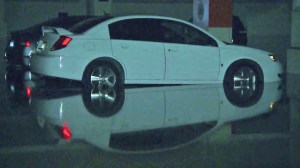
Residents of nearby Beverly Glen were set to be allowed to access their homes after providing proof of residence, officials said.
Motorists were urged to use Santa Monica, Wilshire and Olympic boulevards as alternative routes. Metro bus lines 761, 2/302 and 233 were being rerouted as a result of the street closure, according to the L.A. County Metropolitan Transportation Authority.
The location of the rupture had complicated repair efforts, according to Jeff Bray, the DWP’s general superintendent for water distribution.
“Normally, a break of this size, we would just go in and cut out a section of pipe and replace it real quick. But this is located where two large-diameter pipes come together,” Bray said.
He stated that water in the area is safe to drink, and that no DWP customers had their service interrupted as a result of Tuesday’s incident.
At UCLA, the deluge caused “substantial” damage to six facilities including the famed Pauley Pavilion athletic arena, as well as the two underground parking structures, a university official said. Two workers were hospitalized and four were treated after being exposed to carbon monoxide fumes coming from equipment at Pauley Pavilion on Wednesday evening, according to the Los Angeles Fire Department.
The campus was open on Wednesday, with the exception of its two child-care centers. UCLA Camp activities were temporarily suspended, as were all campus recreation activities.
Crews had worked throughout the night to clear debris, and large blowers were being used at the John Wooden Center and other buildings, according to Assistant Vice Chancellor Kelly Schmader.
“We’re currently in the drying process” at Pauley Pavilion, home of the Bruins’ basketball, gymnastics and volleyball teams, whose court was “showing little signs of buckling and expansion” after being flooded by 8 to 10 inches of water, Schmader said.
“Whether we’ll be able to save that court, I don’t know,” he added.
The flooding of the arena comes about two years after the completion of a 2-1/2-year, $136-million renovation.
On Wednesday morning, standing water was still being pumped from parking structures 4 and 7. Just under half of the cars inside the structures were completely submerged.
Vehicle owners were instructed to stay away from the parking structures, which were closed, and to instead fill out an online form describing their vehicle and its location.
More Video:
